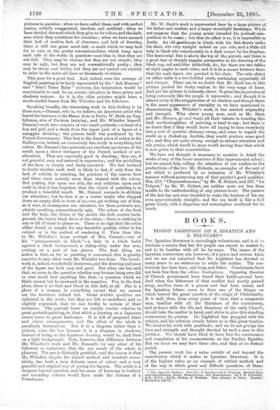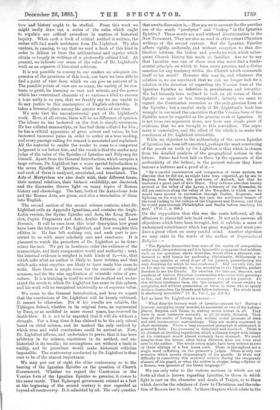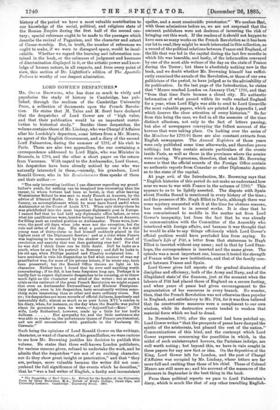BOOKS.
BISHOP LIGHTFOOT ON S.. IGNATIUS AND S. POLYCARP.*
THE Ignatian literature is exceedingly voluminous, and is of so intricate a nature that but few people can expect to master it, and to be familiar with all its by-ways. The issues of the Ignatian controversy are, however, of a grave and serious kind, and we are not surprised that Dr. Lightfoot has devoted ea many years to an endeavour to settle the matter. The con- troversy has been keen, and long, and bitter. Combatants have not been free from the odium theologicum. Opposing theories of Church government have found their battle-ground here. And when the bitterness of that conflict had mostly passed. away, another issue of a graver sort had been raised, and the Ignatian letters came to form one of the hinges on which turned the great question of the origin of Christianity. It is well, then, from every point of view, that a competent man, familiar with all the literature of the controversy, and at home with the life and literature of the early Church, should take the matter in hand, and strive to give this standing controversy its quietus. Dr. Lightfoot has grappled with the subject, and his solution stands before us in this great treatise. We receive his work with gratitude ; and we do not grudge the time and strength and thought devoted by such a man to this problem. We should have liked to have had the continuance and completion of his commentaries on the Pauline Epistles. But we trust we may have these also, and that at no distant period.
The present work has a value outside of and beyond the contribution which it makes to Ignatian literature. It is of the highest value as an example of critical method, and of the way in which great and difficult questions of litera-
The Apostolic Fathers. Part IL—S. Ignatius and S Poknerp. Revised Text, with Introduction, Notes, Dissertations, and Translations. By J. B. Lightfoot, D.D., D.C.L., LLD., Bishop of Durham. Two volumes in three. London t Macmillan and Co.
titre and history ought to be studied. From this work we might easily draw out a series of the rules which ought to regulate our critical procedure in matters of historical inquiry. When such a book of critical method is written, the writer will find much assistance from Dr. Lightfoot. We also venture, in passing, to say that we need a book of this kind in order to deliver us from the arbitrariness and caprice which obtain so largely in writings of a professedly critical kind. At present, we indicate our sense of the value of Dr. Lightfoot's work as an organon of historical criticism.
It is not possible to convey to our readers an adequate im- pression of the greatness of this book, nor have we been able to find a point of view from which we can give an account of it. The possible points of view are so many, the variety of its con- tents so great, its learning so vast and minute, and the power which has constrained elements of so various a kind to assume a true unity is so rare, that we frankly say we are unable to do any justice to this masterpiece of English scholarship. It takes a foremost place among the greater works of our time.
We note first the uncontroversial part of Dr. Lightfoot's work. Here, at all events, there will be no difference of opinion. The labour he has bestowed on the text is simply enormous. He has collated manuscripts, or has had them collated for him ; he has a critical apparatus of great extent and value; he has bestowed immense pains in order to arrive at a true reading, and every passage calling for remark is annotated and explained. All the material to enable the reader to come to a competent judgment is set before him, and the result is that the reader may judge of the value of the Epistles of Ignatius and Polycarp for himself. Apart from the General Introduction, which occupies a large volume, Dr. Lightfoot has a more special Introduction to the seven Epistles of Ignatius, which he considers genuine, and each of them is analysed, annotated, and translated. The Acts of Martyrdom, are also dealt with, their different forms, their mutual relations, their historic credibility, are discussed, and the discussion throws light on many topics of Roman history and chronology. The text, both of the Antiochene Acts and the Roman Acts, are given, and also a translation, of them into English.
The second section of the second volume contains what Dr. Lightfoot calls an Appendix Iguatiana, and contains the Anglo- Latin version, the Syriac Epistles and Acts, the Long Recen- sion, Coptic Fragments and Acts, Arabic Extracts, and Lana Heronis. It will be seen from this brief description how great have been the labours of Dr. Lightfoot, and how complete this edition is. He has left nothing out, and each part is pre- sented to us with more scholarly care and exactness. It is pleasant to watch the procedure of Dr. Lightfoot as he deter- mines the text. We get in luminous order the evidence of the manuscripts, and their comparative worth and authority ; next, the internal evidence is weighed in both kinds of it,—viz., that which asks what an author is likely to have written, and that which asks what copyists are likely to have made him seem to write. Here there is ample room for the exercise of critical acumen, and for the nice application of scientific rules of pro- cedure. It is a training in itself to note the method and under- stand the result to which Dr. Lightfoot has come in this sphere, and his work will be recognised universally as of supreme value.
We come to the General Introduction, and here we expect that the conclusions of Dr. Lightfoot will be keenly criticised. It cannot be otherwise. For if his results are reliable, the Tubingen School, whether in its original form, as represented by Baur, or as modified in more recent years, has received its death-blow. It is not to be expected that it will die without a struggle. For a long time it has claimed to be the only school based on strict science, and its method the only method by which true and valid conclusions could be arrived at. Now, Dr. Lightfoot affirms, and undertakes to prove, that it has been arbitrary in its science, capricious in its method, and un- historical in its results ; its assumptions are without a basis in reality, and its procedure would make historical criticism impossible. The controversy conducted by Dr. Lightfoot is thus seen to be of the utmost importance.
We may put out of sight the older controversy as to the bearing of the Ignatian Epistles on the question of Church Government. Whether we regard the Curetonian or the Vossian form of the Ignatian Epistles as genuine, it comes to the same result. That Episcopal government existed as a foot at the beginning of the second century is now regarded as beyond all controversy. It is admitted by all. The only question that awaits discussion is,—How are we to account for the peculiar use of the words "presbyter" and " bishop " in the Ignatian Epistles ? These words are used without discrimination in the New Testament. They are also so used in other extant Christian writings of the second century. But the Ignatian Epistles adhere rigidly, uniformly, and without exception to that dis- tinction between the bishop and presbyter with which subse- quent Church history has made us familiar. Are we to say that Ignatius was one of those men who must find a funda- mental principle on which to base every practice, and a divine sanction for any tendency within the Church which commends itself to his mind? However this may be, and whatever the solution is, we are convinced that we can no longer look for a solution in the direction of regarding the Vossian form of the Ignatian Epistles as defective in genuineness and integrity. We had formerly been inclined to look on all forms of these Epistles as more or less interpolated ; latterly we came to regard the Curetonian recension as the only genuine form of the Epistles ; but a careful study of Dr. Lightfoot's book has wrought in our mind the conviction that the Vossian form of the Epistles must be regarded as the genuine work of Ignatius. It is not from one argument alone, nor from any single piece of evidence, that we are brought to this conviction. The argu- ment is cumulative, and the effect of the whole is to make the conclusion of Dr. Lightfoot irresistible.
While no objection to the authenticity of the seven Epistles of Ignatius has been left unnoticed, perhaps the most convincing of the proofs set forth by Dr. Lightfoot is that which is chosen from the detailed analysis of the geographical notices in the letters. Stress had been laid on these by the opponents of the authenticity of the letters ; in the present volume they have become a buttress and a proof of it :—
"By a careful examinatioa and comparison of these notices, we discover that he did not as might have been expected, go by sea to Smyrna from Seleucia, the port-town of Antioch, but that he traversed a great part of Asia Minor. They indicate also that having arrived at the valley of the Lyons, a tributary of the Menander, he did not continue along the valley of the Maaarader, in which case he would have passed in succession through Trent*, Magnesia, and Ephesus, on hie way to Smyrna, but took the northward branch of the road leading to the valleys of the Cogamna and Heroine, and thus be would pass through Philadelphia and Sardis before reaching his goal." (Vol. I., p. 348.) On the supposition that this was the route followed, all the allusions to places fall into lucid order. It not only answers all objections which have been brought, but it exhibits a mass of undesigned coincidences which has great weight, and must pro- duce a great effect on every candid mind. Another objection we may state in the words of the author of Supernatural religion :— " The Epistles themselves bear none of the marks of composition under such circumstances, and it is impossible to suppose that soldiers, such as the quotation above describes, would allow a prisoner, con- demned to wild beasts for professing Christianity, deliberately to write long epistles at every stage of his journey, promulgating the very doctrines for which he was condemned. And not only this, but on his way to martyrdom, be has, according to the Epistles, perfect freedom to see his friends. He receives the bishops, deacons, and numbers of various Christian communities who come with greetings to him, and devoted fAlovrers accompany him on his journey. All this without hindrance from the 'ten leopards,' of whose cruelty he complains, and without persecution or harm to those who so openly declare themselves his friends and fellow-believers. The whole story is absolutely incredible." (S. R., Vol. I., pp. 267-8.)
Let us hear Dr. Lightfoot in answer : —
"What does the literary work of Ignatius amount to ? Daring a journey, occupying many months, he succeeded at two of his halting- places, Smyrna and Troas, in writing seven letters in all. They were in most instances certainly, in all probably, dictated. They bear all the marks of having been written under pressure of time and with inconvenient surroundings. They are mostly expressed in short sentences. Where a long connected paragraph is attempted, it generally fails. The grammar is dislocated and wrecked. There is no attempt at avoiding repetitious, which a literary forger with leisure at his command would almost certainly have shunned. We could imagine that the letters, after being dictated, were not even read over to the author. The whole seven might have been written at two or three sittings of a few hours each. There is throughout not a single word reflecting on the prisoner's judges. There is only one sentence which speaks disparagingly of his guards. Is there any difficulty in conceiving this sentence written during the temporary absence of his guard, or when the soldier in charge, being a Syrian or a Roman, was ignorant of the Greek language ?"
We can only refer to the various sections in which are set forth all that is known regarding Ignatius, to those in which light is cast on the character and deeds of Trajan, or to those which describe the relations of Jews to Christians, and the rela- tion of Roman law to both. In those chapters which relate to the history of the period we have a most valuable contribution to our knowledge of the social, political, and religious state of the Roman Empire during the first half of the second cen- tury; special reference ought to be made to the passages which describe the revival of Paganism, and the character and extent of Cesar-worship. But, in truth, the number of references we ought to make, if we were to disregard space, would be incal- culable. Whether we regard the learning and information con- tained in the book, or the calmness of judgment and keenness of discrimination displayed in it, or the artistic power and know- ledge of human nature, in all respects, and from every point of view, this section of Dr. Lightfoot's edition of The Apostolic Fathers is worthy of our deepest admiration.




































 Previous page
Previous page